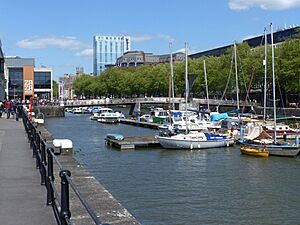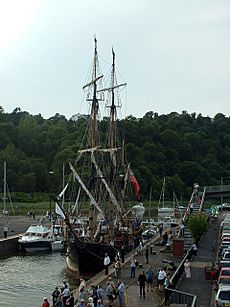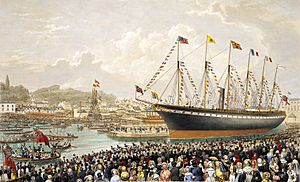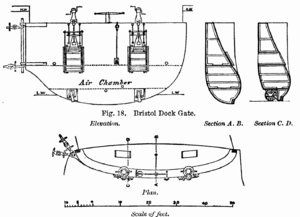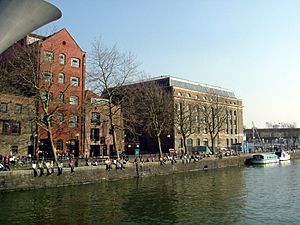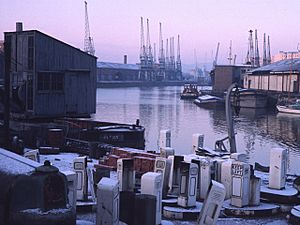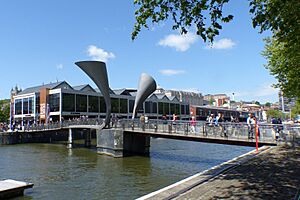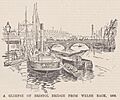Bristol Harbour facts for kids
Bristol Harbour is a special part of the city of Bristol, England. It covers about 70 acres (28 hectares) of water. This harbour used to be a natural river called the River Avon. But in 1809, engineers changed it so the water level would always stay the same. This is why it's often called the Floating Harbour.
To make the Floating Harbour, a new channel was dug for the River Avon. This new channel is about 2 miles long and is known as the "New Cut." It allows the river's tides to flow without affecting the harbour's water level. This means boats in the harbour always stay afloat, even when the tide is low in the main river.
At the eastern end of the harbour, there's a place called Netham Lock. This lock marks the start of the Floating Harbour. From here, the Feeder Canal flows for about 1 mile. This canal connects to the main River Avon, which continues upstream towards Bath.
The Floating Harbour winds through the heart of Bristol, past places like Bristol Temple Meads railway station and Hotwells. At Hotwells, the harbour connects back to the tidal River Avon through a series of locks. From there, the river flows into the beautiful Avon Gorge.
Bristol Harbour was once the main Port of Bristol. But as ships became much bigger, new docks were built further downstream at Avonmouth and Portbury. Today, these larger docks handle most of the big cargo ships. Bristol Harbour itself is now a lively place for fun, history, and smaller boats.
Contents
Exploring Bristol Harbour
- Prince's Wharf, including M Shed, Pyronaut and Mayflower adjoining Prince Street Bridge
- Dry docks: SS Great Britain, the Matthew
- St Augustine's Reach, Pero's Bridge
- Bathurst Basin
- Queen Square
- Bristol Temple Meads railway station
- Castle Park
- Redcliffe Quay and Redcliffe Caves
- Baltic Wharf marina
- Cumberland Basin & Brunel Locks
- The New Cut
- Netham Lock, entrance to the Feeder Canal
- Totterdown Basin
- Temple Quay
- The Centre
- Canons Marsh, including Millennium Square and At-Bristol
- Underfall Yard
- Bristol Bridge
A Look Back: Bristol's Harbour History
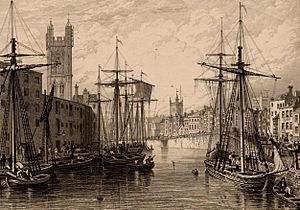
Bristol grew up around its rivers, the Avon and the Frome. For hundreds of years, people changed these rivers to make them better for ships. In the 1240s, part of the River Frome was dug into a deeper channel. This became the busy heart of Bristol's docks.
The River Avon has very strong tides, which can rise and fall by about 47 feet (14 meters). This meant ships could easily sail in at high tide. But at low tide, the river turned into a muddy channel, and ships would often get stuck. To deal with this, sailors had to make sure their ships and cargo were very secure. This led to the famous saying "wikt:shipshape and Bristol fashion!" It meant everything was perfectly organized and tied down.
Bristol was an important port for exploration. As early as 1420, Bristol ships sailed to Iceland. Some people even think Bristol sailors might have reached the Americas before Christopher Columbus or John Cabot. When John Cabot came to Bristol, local merchants helped him sail west across the Atlantic. He hoped to find a shorter route to Asia. These merchants, called the Society of Merchant Venturers, had already been exploring the North Atlantic since the 1480s. In 1552, King Edward VI gave them the job of managing the port.
By 1670, Bristol had many ships, with half of them bringing in tobacco. Later, in the late 1600s and early 1700s, Bristol ships also played a sad role in the slave trade. This was a time when people were cruelly taken from their homes and forced to work.
Building the Floating Harbour
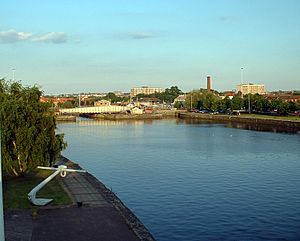
In the 1700s, docks in other cities like Liverpool grew bigger. Bristol's old docks had problems because of the tides. So, in 1802, an engineer named William Jessop suggested a big idea. He proposed building a dam and a lock to create a harbour where the water level would always stay the same.
This huge project cost a lot of money, about £530,000. Construction started in 1804. It included building the Cumberland Basin, a wide area of the harbour with historic walls. A new tidal channel, the New Cut, was also dug. This allowed the River Avon to flow around the city without affecting the new harbour.
The new harbour needed a way for boats to move between the calm harbour water and the tidal river. Jessop designed the Cumberland Basin with two entrance locks. These locks allowed ships to pass safely. The Floating Harbour officially opened on May 1, 1809.
Many ships were built in the Floating Harbour. Two of the most famous were designed by Isambard Kingdom Brunel: the SS Great Western (1838) and the SS Great Britain (1843). These were some of the largest ships of their time. The SS Great Britain was so big that it couldn't fit through the lock easily! Parts of the lock had to be removed to let it pass in 1844.
Improvements in the 1800s
The new harbour was expensive, and high fees were charged to ships. This made it hard for Bristol to compete with other ports. In 1848, the city council took over the docks to lower the costs. They hired Brunel again to make improvements. He designed new lock gates and special sluice gates to help clean out mud from the harbour.
By the mid-1800s, steamships offered regular passenger services from Bristol to many towns in Ireland and Wales. But as ships grew even larger, the winding River Avon made it difficult for very big vessels to reach the harbour. New docks were eventually built closer to the sea at Avonmouth and Portishead. In 1873, a wider entrance lock was opened at the City Docks, which is still used today.
From 1893 to 1934, the Clifton Rocks Railway was a unique funicular railway. It ran inside the cliff face, connecting the harbour to the high area of Clifton.
Harbour Railways
The Bristol Harbour Railway opened in 1872. It connected Bristol Temple Meads railway station to the Floating Harbour. This railway even went through a tunnel under St Mary Redcliffe church! Later, more railway lines were added to move goods around the busy docks.
Underfall Yard

The Underfall Yard is a special place where the harbour's machinery and boats are maintained. It was built on land that appeared when the river was dammed. In the 1830s, the harbour was getting very muddy. Brunel came up with a clever solution. He designed powerful sluice gates that would open at low tide. These gates created a strong current that sucked the mud out of the harbour and into the tidal river.
Many old buildings from the 1880s still stand at Underfall Yard. The tall, eight-sided brick chimney of the hydraulic engine house is very old and important. This engine house contains powerful pumps that use water pressure to operate the harbour's cranes, bridges, and locks.
Harbour Warehouses
Many large warehouses were built around the harbour to store goods. Some of these old buildings are still here today. Many have been turned into apartments, while others have become cultural centers.
For example, the A Bond Tobacco Warehouse, built in 1905, was one of the first large brick warehouses. The B Bond Warehouse (1908) was one of the first buildings in Britain to use reinforced concrete. Today, it holds the Bristol Archives and council offices.
Other warehouses, like Robinson's Warehouse and the Granary, show off a unique "Bristol Byzantine" style with colorful bricks and interesting arches. The Arnolfini art gallery and the Watershed Media Centre are also located in old warehouses.
The Harbour in the 1900s
By 1908, the Royal Edward Dock was built at Avonmouth. Later, in 1972, the huge Royal Portbury Dock opened. These new, deep-water docks meant that the old Bristol City Docks were no longer needed for large cargo ships. However, smaller trading ships continued to use the city docks until the early 1970s.
The last shipbuilder at the Albion Yard, Charles Hill & Sons, closed in 1977. But part of the yard reopened in 1980 as Abels Shipbuilders, which built many small ferries and tugs until 2006.
The old swing bridge at the Junction Lock is still powered by water pressure from the Underfall Yard engine house. A newer bridge, the Plimsoll Bridge, opened in 1965 and uses a modern electro-hydraulic system.
Making the Harbourside New Again
Since the 1980s, a lot of money has been spent making the harbourside a vibrant place again. In 1999, Pero's Bridge was built. This bridge connects different parts of the harbour, making it easier for people to explore. In 2000, the @Bristol science centre opened on land that used to be empty. Many old buildings were also fixed up and given new life.
This renewal project has cost hundreds of millions of pounds. New flats, homes, and offices have been built along the water. The Cumberland Basin is now used by many small boats and is surrounded by tourist attractions. Even the old hydraulic pumping station has been turned into a pub!
Today, there are two active boat building companies in the harbour: Bristol Classic Boat Company and the Slipway Co-operative at the Underfall Yard.
Bristol Harbour Today
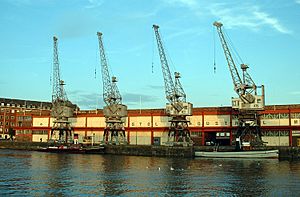
Today, Bristol Harbour is a fantastic place for visitors. It's full of museums, art galleries, exhibitions, cafes, and shops. Old workshops and warehouses have become exciting cultural spots. These include the Arnolfini art gallery, the Watershed media and arts centre, the M Shed museum, and the We The Curious science centre. Many stylish apartments have also been built.
The Bristol Harbour Railway, run by M Shed, sometimes offers rides on weekends. You can also see historic boats permanently docked here. These include Isambard Kingdom Brunel's famous SS Great Britain, the first iron-hulled ocean liner. There's also a replica of the Matthew, the ship John Cabot sailed to North America in 1497.
Bristol Ferry Boats and Number Seven Boat Trips offer fun ferry rides along the harbour. You can hop on near Temple Meads station and visit many attractions. There's even a small ferry that takes people across the harbour. Bristol Packet Boat Trips offer guided tours of the harbour and river cruises up the Avon to Bath.
Every year in late July, the Bristol Harbour Festival takes place. This huge event brings in many boats, including tall ships and Royal Navy vessels. It's a lively celebration with music, street performances, and lots of visitors.
Harbour Events
The Bristol Harbour Festival is a highlight of the year, happening every July. Hundreds of boats fill the harbour, and about 200,000 people come to enjoy the music, shows, and beautiful ships.
In 1996, the harbour hosted the first International Festival of the Sea. This was an even bigger event, with many famous tall ships. It celebrated John Cabot's journey to the Americas, and a replica of his ship, the Matthew, was dedicated there. In 2009, the harbour celebrated its 200th birthday with special events.
In June 2020, a statue of Edward Colston, a historical figure linked to the slave trade, was removed from its base by protestors and pushed into the harbour. This event became a significant moment in the harbour's recent history.
Images for kids
See also
- Port of Bristol
- Bristol Harbour Festival
- Bristol Marina


